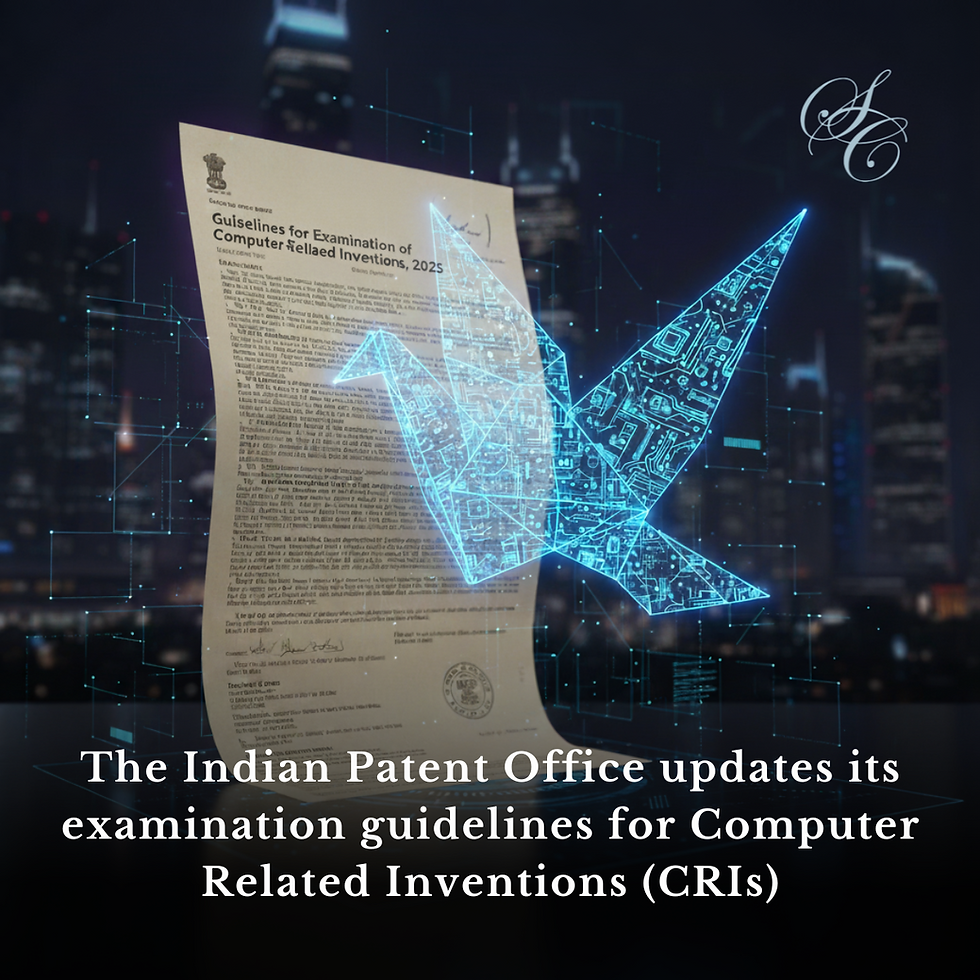Stern Advisory issued to e-commerce platforms mandating self-regulation of Dark Patterns
- SC IP
- Jun 25
- 5 min read

The Advisory for the regulation of Dark Patterns
The Central Consumer Protection Authority (“CCPA”) has recently on 5 June 2025, released an advisory for e-commerce platforms focusing on the regulation of dark patterns. The aim is to prevent these platforms from engaging in “deceptive and unfair trade practices”.
As per the advisory, e-commerce platforms are required to –
carry out self-audits within three (3) months from the advisory to detect dark patterns and take appropriate steps to eradicate such dark patterns;
the e-commerce platforms are also encouraged to provide self-declarations affirming that their platform is not indulging in any dark patterns; and
refrain from deploying deceptive design interfaces that mislead consumers or manipulate their decision-making.
The Background
In 2023, the Department of Consumer Affairs (“DCA”), recognizing the concerns posed by dark patterns, had issued the Guidelines for Prevention and Regulation of Dark Patterns (“Guidelines”). The Guidelines outline what constitutes dark patterns, preventing them and thereby strengthening consumer protection in the digital era and curbing unfair practices in e-commerce and online services. The Guidelines apply to all platforms, advertisers and sellers, offering goods/ services in India and provide a regulatory framework against any sort of practices which deceive consumers.
Despite the Guidelines, over the last few years, the National Consumer Helpline continued to receive multiple complaints from consumers regarding dark patterns. The CCPA also continued to observe various violations by major e-commerce platforms, such as Amazon, Uber, Ola, Rapido, Zepto, etc., and issued notices to eleven (11) such platforms for using manipulative tactics to mislead consumers.
Following this, in May 2025, the DCA convened a meeting with various stakeholders, such as e-commerce platforms, industry associations, consumer organizations, and National Law Universities to discuss the prevalence of dark practices. In the meeting, various issues were highlighted, and the platforms were urged to act proactively to create a transparent and safe digital space for consumers. This advisory is a continuation of the Guidelines, and the issues identified in the meeting.
The DCA has been keeping a close watch on the violation of the Guidelines issued for prevention and regulation of dark patterns. The DCA has also constituted a Joint Working Group (“JWG”) which will examine and undertake measures to the violations by e-commerce platforms and share such violations with the DCA. The JWG shall also suggest appropriate awareness programmes for creating awareness amongst the consumers.
What are Dark Patterns as per the Guidelines?
In the Guidelines, dark patterns have been defined as “any practices or deceptive design pattern using user interface or user experience interactions on any platform that is designed to mislead or trick users to do something they originally did not intend or want to do, by subverting or impairing the consumer autonomy, decision making or choice, amounting to misleading advertisement or unfair trade practice or violation of consumer rights”.
In the Guidelines, the CCPA has identified thirteen (13) dark patterns, which are as follows:
(i) False Urgency:
Making false statements to imply popularity/ scarcity of a product, to mislead consumers into making an immediate purchase. For instance, displaying the message “offer ends in 10 minutes” to create false urgency so that consumers have to make a decision in haste.
(ii) Basket Sneaking:
Including additional items at the time of checkout, without a consumer consent, leading to the consumer paying more than was required for the product/ service purchased by him/her. Such additional items can include payment to a charity, subscription to the service, travel insurance, etc. For instance, automatically including a donation at the time of checkout.
(iii) Confirm Shaming:
Using a phrase, video, audio or any other means to create a sense of fear/ shame/ ridicule/ guilt in the mind of the consumer which forces the consumer to purchase something. For instance, guilting the consumers to donate by displaying the message “Don’t be a cheapskate, donate to charity”.
(iv) Forced Action:
Forcing a user into buying any additional goods or subscribing for an unrelated service. For instance, making consumers sign up for updates before a purchase in made.
(v) Subscription Trap:
(a) Making cancellation of a paid subscription impossible or a complex process; (b) hiding the cancellation option for a subscription; (c) forcing a user to provide payment details for auto debits for a free subscription; (d) making the instructions related to cancellation of subscription ambiguous/ confusing.
(vi) Interface Interference:
A design element that manipulates the user interface in ways that conceals relevant information as compared to other things or to misdirect a user from taking an action as desired. For instance, when a consumer clicks on a X mark, the page redirects to an advertisement.
(vii) Bait and Switch:
The practice of advertising a particular outcome based on the consumers action but deceptively serving an alternate outcome. For instance, clicking on an ad to purchase a service worth Rs. 100, but at checkout the total amount increases with additional costs.
(viii) Drip Pricing:
(a) Revealing the price of products/ services post-confirmation of purchase; (b) a product or service is advertised as free without appropriate disclosure of the fact that the continuation of use requires in-app purchase; (c) consumer is prevented from availing a service which is already paid for unless something additional is purchased. For instance, hiding that there will be an additional cost for delivery to purchase an item.
(ix) Disguised Advertisements:
Masking advertisements as other content, such as new articles, which are designed to blend in with the rest of an interface in order to trick customers into clicking on them. For instance, not disclosing where there is a paid promotion for a product and disguising it as a genuine review.
(x) Nagging:
Repeated and persistent interactions, in the form of requests, information, option, to make a transaction. For instance, pop-ups appearing at each step to enable notifications.
(xi) Trick Question:
Use of confusing or vague language, in order to misguide a consumer from taking desired action.
(xii) SaaS billing:
Generating and collecting payments from consumers on a recurring basis in a software as a service (SaaS) business model by exploiting positive acquisition loops in recurring subscriptions to get money from users as surreptitiously as possible. For instance, where you are required to provide your card details before signing up for a free trial and an amount is deducted once the free trial ends without prior consent of consumer.
(xiii) Rogue Malwares:
Using a ransomware or scareware to mislead consumer into believing there is a virus on their computer and to convince them to pay for a fake malware removal tool.
Cause and Consequence
The world is increasingly identifying the need to come up with clear regulatory guidelines to tackle dark patterns plaguing the digital space worldwide. For example, the European Union has formulated the Digital Services Act, 2024 to address concerns regarding dark patterns. Further, the Federal Trade Commission has been proactively taking action against platforms involved in dark patterns and has also penalised big platforms, such as Amazon and Epic Games, recently. There is a growing global trend across countries to identify, regulate, and eliminate dark patterns in the digital set up, signalling a collective shift toward more transparent and user-respecting online experiences.
India, through the Guidelines intends to protect consumers in the digital space by clearly identifying and prohibiting manipulative online design practices that deceive or mislead users. The Advisory and creation of the JWG goes a step forward, making the e-commerce platforms accountable by mandating self- regulation in a specified time-bound manner.
Although the Advisory comes as a relief to consumers, it is likely to have significant implications for e-commerce platforms, such as the increased compliance burden. It is likely that the self-audits will require substantial monetary investment from e-commerce platforms and failure to eliminate dark patterns could lead to regulatory actions, penalties and civil/criminal liabilities.




Comments